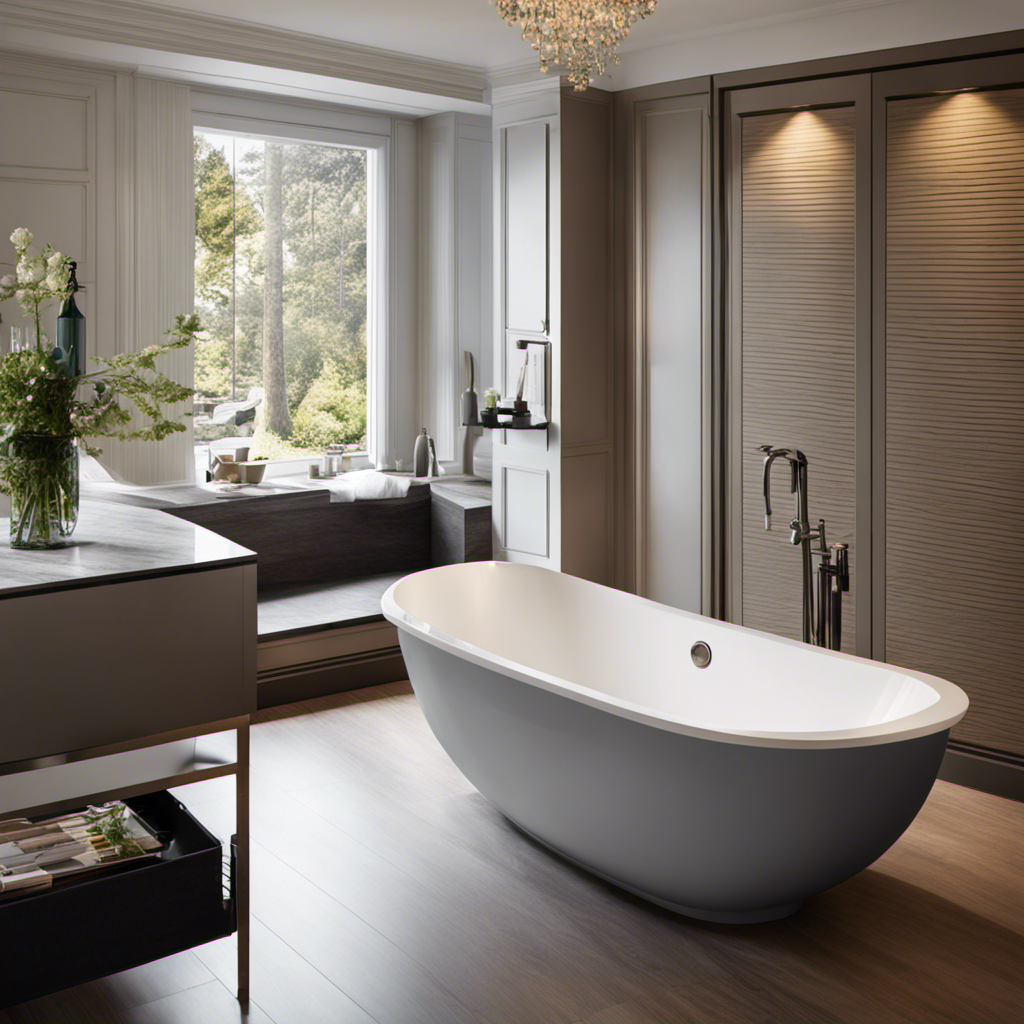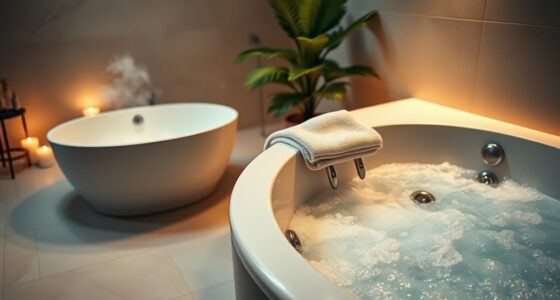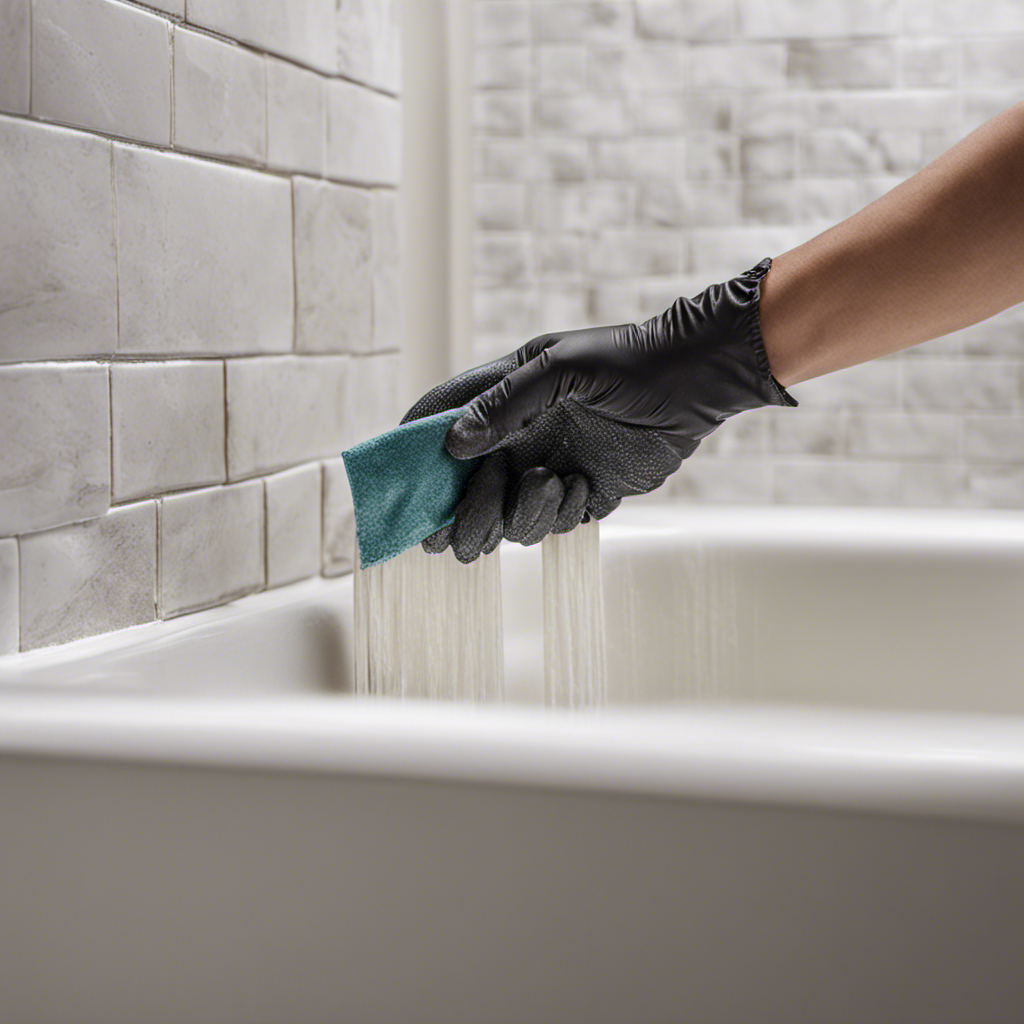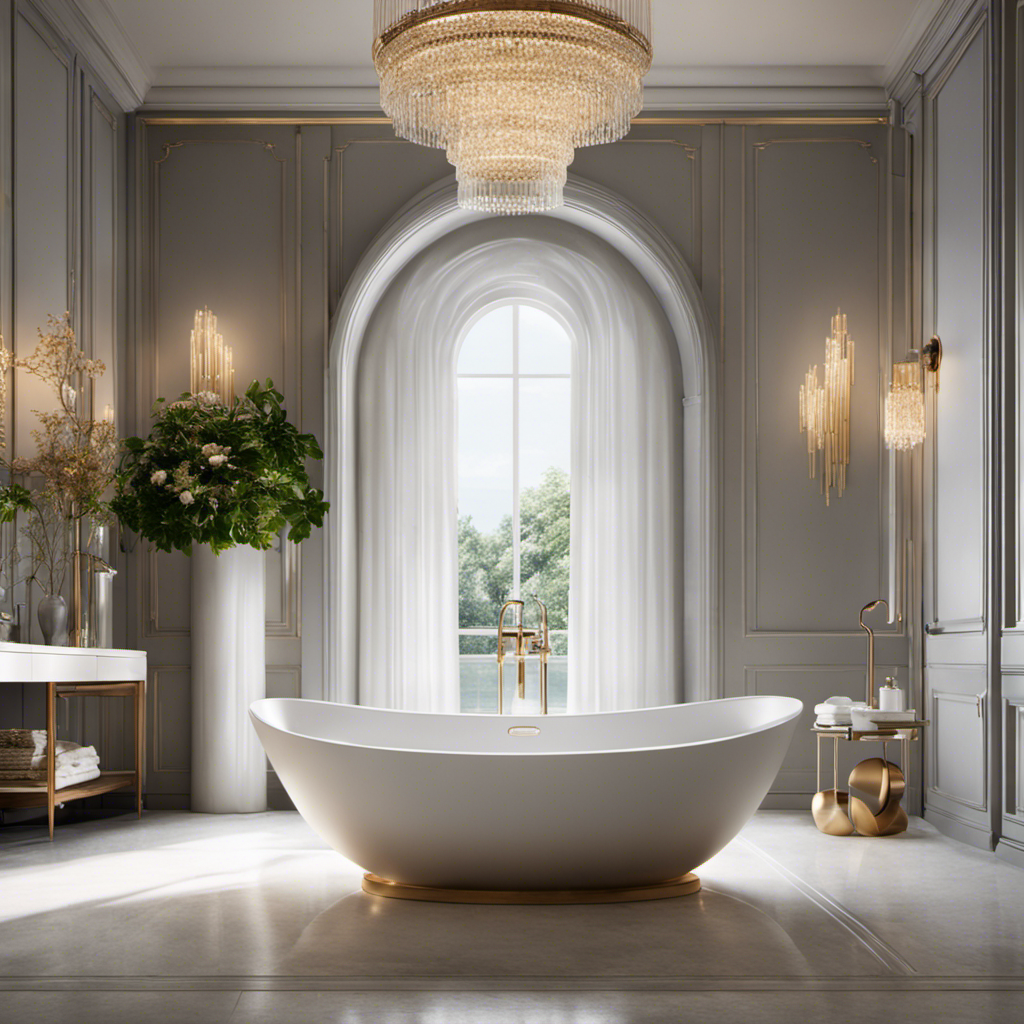Looking to upgrade your bathroom? Wondering what size bathtub will fit perfectly in your space? Look no further!
In this article, we’ll dive into the world of standard bathtub sizes, providing you with all the information you need to make an informed decision. From the average dimensions to common sizes, we’ve got you covered.
So sit back, relax, and let us guide you through the world of bathtubs and their dimensions.
Key Takeaways
- The average bathtub dimensions are around 60 inches long and 30 inches wide.
- Optimal bathtub depth varies depending on personal preference and tub type, with deep soaking tubs usually having a depth of around 20 inches or more.
- Small tubs have advantages such as space-saving, water conservation, and easier cleaning, while larger tubs provide a luxurious bathing experience.
- Common bathtub widths range from 30 to 32 inches, and considerations for selecting the right size tub include measuring available space, personal preference for comfort, and ensuring it fits with the bathroom layout.
Average Bathtub Dimensions
If you’re wondering about the average bathtub dimensions, it’s typically around 60 inches long and 30 inches wide.
However, when it comes to the optimal bathtub depth, it varies depending on personal preference and the type of tub you choose.
Deep soaking tubs are becoming increasingly popular for those seeking a luxurious and relaxing bathing experience. These tubs are designed to allow for a deeper water level, usually around 20 inches or more, allowing you to fully submerge and unwind.
The extra depth provides a soothing and therapeutic sensation, relieving muscle tension and promoting relaxation.
Deep soaking tubs come in various shapes and sizes, so you can find one that fits your bathroom space and meets your specific bathing needs.
Common Bathtub Sizes
When it comes to choosing the right bathtub, understanding the optimal dimensions is key. The size of your tub can greatly impact your bathing experience, so it’s important to consider the pros and cons of small versus large tubs.
In this discussion, we will explore the ideal bathtub dimensions for maximum comfort and functionality, as well as the benefits and drawbacks of both smaller and larger tubs.
Optimal Bathtub Dimensions
You should consider the optimal dimensions for your bathtub. Choosing the right size can greatly enhance your bathing experience.
Here are some tips to help you find the perfect dimensions for your bathtub:
-
Comfort: Opt for a size that allows you to fully stretch your legs and relax. Consider your height and build to ensure maximum comfort.
-
Space: Take into account the available space in your bathroom. Measure the area where the bathtub will be installed to avoid any fitting issues.
-
Functionality: Consider the purpose of your bathtub. If you enjoy long soaks, a deeper tub might be ideal. If you have children or elderly family members, a shallower tub with a wider ledge for easy access is recommended.
When it comes to materials, choose one that is durable, easy to clean, and resistant to stains. Acrylic, fiberglass, and porcelain are popular choices.
As for installation, make sure to hire a professional to ensure proper fitting and sealing.
Small Vs. Large Tubs
Small tubs are ideal for bathrooms with limited space, while larger tubs provide a luxurious bathing experience.
If you have a small bathroom, a small tub offers several advantages. Firstly, it saves space, allowing you to maximize the available area. Secondly, a small tub requires less water to fill, which can help conserve water and reduce your water bill. Additionally, small tubs are easier to clean and maintain, as there is less surface area to scrub.
On the other hand, larger tubs have their disadvantages. They take up more space, which can be a challenge in smaller bathrooms. Moreover, filling a larger tub requires more water, which can be wasteful and costly. Larger tubs also require more time and effort to clean, as there is more surface area to cover.
Standard Length of a Bathtub
If you’re looking for a standard bathtub, the typical length is around 60 inches. This is the most common size you’ll find for residential bathrooms. However, there are also smaller and larger tubs available, depending on your personal preference and the size of your bathroom.
When it comes to the weight of a bathtub, it can vary depending on the material it is made of. Here are some popular options and their average weights:
-
Acrylic: This lightweight material is easy to install and has an average weight of around 70-100 pounds.
-
Cast Iron: Known for its durability and heat retention, cast iron tubs are heavy, with an average weight of 300-500 pounds.
-
Fiberglass: These tubs are lightweight and affordable, weighing in at around 50-100 pounds on average.
Choosing the right bathtub material and size is important for creating a comfortable and functional bathroom space.
Width of Standard Bathtubs
When it comes to choosing the right bathtub, understanding the common bathtub widths is essential.
The width of a standard bathtub can vary, but the most common widths range from 30 to 32 inches.
Common Bathtub Widths
You’ll find that most standard bathtubs come in widths ranging from 30 to 32 inches. However, there are some variations to consider when it comes to selecting the right size bathtub for your needs.
Here are a few bathtub size considerations to keep in mind:
-
Average bathtub depth: The depth of a standard bathtub is typically around 14 to 17 inches. This depth allows for a comfortable soak while ensuring that the water level is high enough to cover your body.
-
Space limitations: Before purchasing a bathtub, measure the available space in your bathroom to ensure that the width of the tub fits comfortably. Consider the layout of your bathroom and any surrounding fixtures that may impact the placement of the tub.
-
Personal preference: Ultimately, the size of your bathtub should align with your personal preferences and needs. If you enjoy taking long, luxurious baths, you may want to opt for a wider bathtub that can accommodate your desired level of comfort.
Choosing the Right Size
When selecting the perfect tub for your bathroom, it’s important to consider the available space and your personal preferences.
Choosing the right size is crucial to ensure that the tub fits seamlessly into your bathroom layout. Start by measuring the available space to determine the maximum dimensions your tub can have. Take into account any obstructions like doors or windows that may limit the size.
Once you have the measurements, you can begin the process of finding the perfect material. There are various materials to choose from, such as acrylic, cast iron, or fiberglass. Each material has its own advantages and disadvantages in terms of durability, maintenance, and appearance. Consider factors like cost, ease of cleaning, and longevity when making your decision.
Height of Standard Bathtubs
To comfortably soak in a standard bathtub, you’ll need to consider its height. The height of a bathtub plays a crucial role in ensuring a relaxing and enjoyable bathing experience.
Here are three important considerations when it comes to bathtub height options:
-
Ergonomics: A bathtub should have a height that allows you to easily step in and out without straining your legs or back. It should provide a comfortable seating position, allowing you to fully relax and unwind.
-
Accessibility: For individuals with limited mobility or disabilities, a lower bathtub height may be more suitable. This ensures ease of entry and reduces the risk of accidents or falls.
-
Water depth: The height of the bathtub also determines the water depth you can achieve. If you enjoy deep soaking baths, consider a taller bathtub that allows for a greater water level.
When choosing a standard bathtub, be sure to take these height considerations into account to create a bathing space that is both comfortable and enjoyable.
Small Bathtub Sizes
If you’re looking to maximize space in your small bathroom, there are several space-saving tub options available. These tubs are designed specifically to fit into smaller spaces, allowing you to still enjoy the luxury of a bathtub without sacrificing valuable floor space.
When considering the ideal dimensions for your small bathroom, it’s important to take into account the overall size and layout of the room, as well as any other fixtures or furniture that need to be accommodated.
Space-Saving Tub Options
For a space-saving option, consider a smaller bathtub size that will fit perfectly in your bathroom. These space-saving tub designs offer numerous benefits, making them a popular choice for homeowners looking to maximize their bathroom space.
Here are three reasons why smaller tubs are worth considering:
-
Increased maneuverability: With a smaller bathtub, you’ll have more room to move around in your bathroom. This not only makes it easier to clean, but also allows for easier access to other bathroom fixtures.
-
Energy efficiency: Smaller tubs require less water to fill, which means you’ll use less hot water and save on energy costs. This is not only good for your wallet, but also for the environment.
-
Versatile design options: Despite their smaller size, these tubs come in a variety of stylish designs and materials. From freestanding to corner tubs, you can find a smaller tub that suits your personal taste and bathroom decor.
Ideal Dimensions for Small Bathrooms
Now that you have learned about space-saving tub options, let’s delve into the ideal dimensions for small bathrooms. When it comes to small bathroom design, maximizing space is crucial.
To create a functional and visually appealing bathroom, it is important to carefully consider the size and layout of your fixtures.
For small bathrooms, it is recommended to opt for a compact bathtub that doesn’t compromise on comfort. The ideal dimensions for a small bathroom would be around 5 feet in length and 30 inches in width. This size allows you to have a relaxing bathing experience without taking up too much space.
Additionally, consider installing a corner bathtub or a freestanding tub, as they can help to further optimize the available space in your bathroom.
Large Bathtub Dimensions
To find large bathtub dimensions, measure the available space in your bathroom and consider your desired level of comfort. Large bathtub designs offer several benefits that can enhance your bathing experience:
-
More Space: A larger tub allows you to stretch out and fully relax, giving you the freedom to move around without feeling cramped.
-
Spa-like Experience: Oversized tubs often come with additional features such as built-in jets or whirlpool systems, providing a luxurious and therapeutic bathing experience.
-
Aesthetic Appeal: Large bathtubs can be a statement piece in your bathroom, adding a touch of elegance and sophistication to the overall design.
When choosing a large bathtub, ensure it fits comfortably in your bathroom and complements your personal preferences.
Now, let’s transition into the subsequent section about compact bathtub measurements, which are perfect for smaller spaces or those seeking a more minimalistic look.
Compact Bathtub Measurements
When choosing a compact tub, consider the available space in your bathroom and your personal preferences for a more minimalistic look.
Compact bathtub designs offer a variety of small bathtub options that can fit seamlessly into smaller bathrooms without sacrificing style or functionality. These designs are specifically tailored for limited spaces, making them ideal for apartments, condos, or even tiny houses.
With dimensions ranging from 48 to 60 inches in length and 28 to 32 inches in width, compact tubs are designed to maximize space while still providing a comfortable bathing experience. Some options even include features like built-in storage or whirlpool jets, allowing you to customize your compact tub to suit your specific needs.
Whether you prefer a sleek, modern design or a more traditional style, there is a compact bathtub option that can perfectly complement your bathroom and enhance your bathing experience.
Oversized Bathtub Sizes
If you’re looking for a more luxurious bathing experience, oversized tubs offer ample space for relaxation and comfort. These larger-than-average bathtubs are designed to provide a truly indulgent bathing experience.
Here are three reasons why oversized tubs are worth considering:
-
More space: With their generous dimensions, oversized tubs allow you to stretch out and enjoy a spa-like experience in the comfort of your own home. You can fully immerse yourself in the warm water and let the stress melt away.
-
Versatile materials: Oversized tubs come in a variety of materials, including acrylic, cast iron, and stone. Each material offers its own unique benefits, such as durability, heat retention, and aesthetic appeal. Choose the material that best suits your preferences and needs.
-
Enhanced relaxation: The extra space and luxurious materials of oversized tubs create a soothing environment for relaxation. You can add bath salts, essential oils, or even a bath bomb to enhance the sensory experience and create a true oasis in your bathroom.
Overall, oversized tubs provide a luxurious and indulgent bathing experience, offering ample space, versatile materials, and enhanced relaxation. Treat yourself to the ultimate in comfort and unwind in style.
Custom Bathtub Dimensions
Consider opting for a custom bathtub with dimensions tailored to your specific preferences and needs. Custom bathtub designs offer a unique opportunity to create a bathing space that perfectly fits your lifestyle.
When it comes to customizing the dimensions of your bathtub, the possibilities are endless. You can choose the length, width, and depth of the tub to ensure maximum comfort and relaxation.
Additionally, you can select from a variety of materials for your custom bathtub, such as acrylic, cast iron, or stone. Each material has its own advantages and disadvantages, so it’s important to consider factors like durability, maintenance, and aesthetics.
Frequently Asked Questions
What Are the Pros and Cons of Choosing a Small Bathtub Size?
Choosing a small bathtub size has its pros and cons. On the positive side, it saves space and water, making it ideal for small bathrooms. However, it may be less comfortable and limit your bathing experience.
Are There Any Regulations or Building Codes Regarding the Minimum Dimensions for a Standard Bathtub?
When it comes to regulations and building codes, there are specific requirements for the minimum dimensions of a standard bathtub. These guidelines ensure safety and accessibility in bathroom design.
Can a Standard Bathtub Size Accommodate a Person With Limited Mobility or Someone Who Uses a Wheelchair?
A standard bathtub size may not be suitable for someone with limited mobility or a wheelchair user. However, there are options for bathroom accessibility, such as bathtub modifications or installing a walk-in tub.
Are There Any Bathtub Sizes That Are Specifically Designed for Children or Infants?
When it comes to children’s bathtub sizes, there are options designed specifically for little ones. Choosing a larger bathtub size can offer benefits such as more space to play and grow, making bath time a comfortable and enjoyable experience for your child.
What Factors Should Be Considered When Deciding Whether to Choose a Standard Bathtub Size or a Custom Bathtub?
When deciding between a standard bathtub size or a custom one, consider factors such as space availability, budget, and personal preferences. Standard sizes offer convenience and cost-effectiveness, but custom options provide flexibility and better fit for specific needs.
Conclusion
In conclusion, when it comes to standard bathtub sizes, there are a variety of options to choose from.
From the average dimensions to the common sizes, it’s crucial to consider the length, width, and height of the tub.
For those seeking a larger bathing experience, large bathtubs are available, while compact options cater to smaller spaces.
And for those looking for something truly unique, custom bathtubs offer endless possibilities.
So, whether you desire a relaxing soak or a refreshing shower, finding the perfect bathtub size is essential.










